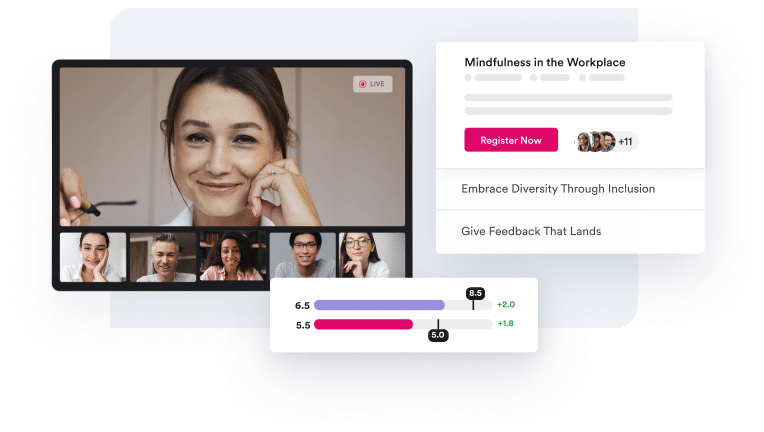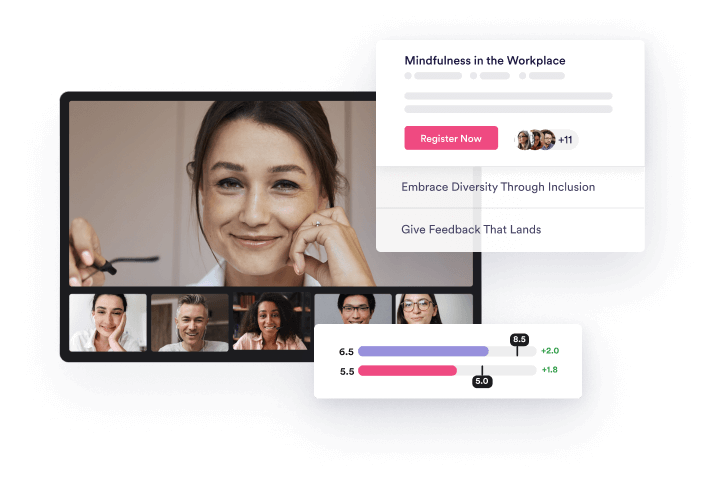I fell in love with people management early in my career. In 2009, we started FanDuel, a sports gaming platform, around a kitchen table in Scotland; it was later acquired for $11 billion. A year later, I remember walking home past Edinburgh Castle, illuminated magnificently at sunset, with a spring in my step after hiring our first two engineers. Until that point, I and another co-founder had done all the coding, and now we finally had some help. Being their manager was my first real management role, and I was euphoric. Not only because the end of 12-hour days of coding was in sight but because I could feel my time and my impact increasing. My appreciation for the power of great management grew over time. As we grew to more than 500 employees in five years, I learned a critical lesson–the key to sustainably growing your company is growing your managers. Excellent front-line and middle managers drive company performance, engagement, and retention. On the flip side, poor management is a destructive force, and there’s plenty of research to back this up. After 10 years at FanDuel, I was struck by how out-of-date the management training industry was. I left to start Hone, a modern manager-training platform to help managers and companies succeed. We help train managers in more than 55 countries. During the pandemic, we saw seismic shifts and adjusted our approach to the new normal, which has contributed to the rise of the Mastery Learning category. We’ve learned what works and what doesn’t on the front lines. I wanted to share some of our lessons learned to help you more effectively train your people managers.
It’s Never Been Harder to Be a People Manager
Managing a team at a high-growth company has never been easy. The shifts in how and where people work added layers of difficulty and complexity. Today, people managers must contend with a myriad of interwoven challenges:
- Remote work management
- The long-term impact of the pandemic, both on physical and mental health
- Racial and other inequities
- A charged political climate
- Disinformation and an erosion of public trust in government and institutions
- New generations of workers with new demands
Managers must juggle these challenges on top of their day jobs, which already require driving exceptional team performance in a competitive marketplace, coaching a mix of personalities, and often doing individual contributor work.
Question: How can we equip these essential team members to excel in this environment?
Answer: We must rethink their training.

Building on What’s Gone Before
Traditional management principles used by technology companies, such as those in Andy Grove’s seminal “High Output Management” and the excellent (but often misused) “Radical Candor,” remain as important today as ever.
We must augment existing structured and logical approaches to management with new levels of empathy and human connection. We see new aspects of our coworkers as they Zoom in from their bedrooms with regular cameos from kids and pets. Work is no longer contained in a vacuum, and personal challenges and feelings sometimes spill over into work.
People managers need a new layer of emotional awareness and mastery on top of their standard toolkit. And company leaders must ensure they get it because their success is mission-critical.
From a how-to-train managers perspective, we can break down the challenge into three parts:
- Content: What to Teach. What mindsets, skillsets, and toolsets do managers need in this new environment?
- Delivery: How to Teach. How can we effectively train people on these nuanced subjects remotely?
- Solutions: Who Should Teach. Given tight resource constraints in HR and L&D, who is going to deliver the content?
Content: What to Teach
At Hone, it has become clear the most critical management skills for the modern workforce are:
- Managing effectively in a hybrid work environment. It’s a tricky balance to keep everyone engaged when some folks are in the office while others work from home. Frequent, clear communication—using everyone’s preferred methods and technology—creates consistency and transparency for the entire team.
- Creating space for psychological safety. Authenticity and bringing your whole self to work are part of many corporate cultures, but employees need psychological safety to do so. Creating an environment where people feel heard and respected is a significant challenge since everyone has unique experiences and perspectives. Managers today must be able to teach that skill.
- Coaching employees. Coaching is all the rage, but how do we teach leaders to coach? Many elements of managing are about getting someone else to do something differently, but coaching is equally about self-management as managing another. Coaching requires managers to utilize multiple techniques, which takes time to learn.
- Providing effective feedback. Nothing changes without feedback, so soliciting it and managing it effectively is critical. However, this remains one area many managers struggle with. Managers must thread the needle between being clear and direct while also communicating their belief the person can do better. And they must do it all with kindness.

Interpersonal Skills
What’s notable about these areas is that they all fall into the category of interpersonal skills. Reading or going through a self-directed program can be helpful in learning a skill practiced alone, like coding or accounting. Interpersonal skills require opportunities to practice and receive feedback. Managers seeking to upgrade how their team provides feedback or move toward a player-coach paradigm must provide chances to practice those new skills before rolling them out with their reports.
These topics cannot be taught in isolation. They are essential layers of core manager skills, such as how to coach or run an effective 1:1. Besides the research-based competency model driving our curriculum, we’ve woven the following threads into our standard manager training approach:
- Remote-first. Co-located work provides a safety net for sloppy management, but remote management must be intentional and explicit. Tools and processes to get the work done are important, but so too is managing the “emotional distance” employees feel when working remotely. Ingraining remote-first practices of making the implicit explicit are more important now due to hybrid work environments.
- Inclusive. Diversity and inclusion are complex issues. Building awareness of bias and belonging, however, can transcend dimensions of race, gender, sexual orientation, and political beliefs. We start with the neuroscience around exclusion and belonging and research on in-group and out-group dynamics. Then we move into actionable topics, such as handling microaggressions, communicating with vulnerability, and seeking to understand first by listening deeply and empathetically.
- Adaptable and Resilient. With our foundations in flux, leaders need adaptability and resilience to manage constant change. As a result, we focus on strategies to build commitment to change, as well as the ability to communicate about company transformation.

Delivery: How to Teach It
When we started Hone in 2018, delivering live, online training (otherwise known as virtual instructor-led training, or VILT) over Zoom was a novelty. Many people mistakenly believed these classes would be a passive experience and often showed up eating a sandwich or in the back of an Uber.
Undeterred, we believed training using live video would become essential given the growth of distributed work. Also, the universal access that live, online training provided was a great equalizer. By disconnecting training from location, upskilling was more accessible to all. Little did we know we were on the brink of a shift so significant that I’ve come to call it the Third Age of Training.
- The First Age of Training was in the physical classroom, often a conference room or hotel ballroom, with a live trainer and a crowd of students. An engaging, if not wholly effective, learning experience due to the brain’s tendency to forget information without spaced repetition (see Ebbinghaus Forgetting Curve). It’s clear that in-person training is more likely to be reserved for special occasions and more senior populations (like annual leadership retreats) rather than upskilling an entire company since it doesn’t scale nor fit the distributed nature of modern work.
- The Second Age of Training was self-paced e-learning: watching videos or clicking through slide decks online with minimal interaction. It’s convenient and scalable and good for individual functional learning by motivated students. But it’s not engaging or effective at teaching skills requiring behavior change through interactive practice and feedback, such as leadership, management, and people skills. And, let’s be honest, it can be mind-numbing for employees not captivated by the subject, and the engagement data backs that up (online courses only see 5-15% completion rates).
- The Third Age of Training is still at the beginning. Only in the past few years have tools like Zoom and WebRTC supported high-resolution face-to-face online classroom experiences easily and cheaply. Small group classes taught this way can be so intimate. We see people laugh, cry, and make career-changing breakthroughs every day at Hone. Combine well-designed live online classes with supporting technology that reinforces and measures learning over time. You can build some of the most powerful educational experiences ever created—and do it at scale.
Let me be clear—we are not talking about webinars. Engaging classes and continuous reinforcement leverage technology’s strengths to create training just as effective as in-person sessions, if not more. Interactive live, online training is where we begin. But continual reinforcement by technology to ingrain behavior change over time is the secret to success.
Here are our top six tips for delivering engaging, effective, blended learning programs through the lens of the brain-friendly learning model MASTER, a neuroscience-based approach to effective learning.
What is MASTER (brain-friendly learning model)?
- Motivate minds. People should be inspired to learn. In a remote setting, a lot of that comes down to the instructors. Without geographical constraints, there’s no reason not to seek out an expert facilitator on the topic. Especially one whose energy jumps out of the screen while delivering a memorable session that connects with everyone, regardless of location.
- Acquire information. People have short attention spans. They get even shorter when they’re remote. Keep pulling them in and “change the channel” every 4-6 minutes. Mix up activities between presentations, discussions, demonstrations, polls, games, breakouts, and more.
- Search for meaning. Allow people to connect new material to their lived experiences through discussions, role-playing, and relevant case studies. Mix up learning styles with interaction for linguistic and interpersonal learners, stats for mathematical and logical learners, and frameworks for visual and spatial learners.
- Trigger memory. Make information memorable, so it’s easy to retrieve. Use acronyms, stories, and top takeaways. Have learners share stories.
- Exhibit learning. Create a safe space to immediately practice new skills, and get feedback from experts and peers. Breakout rooms of pairs or triads are often cited as our learners’ favorite part of the experience. When planned well, they deepen practical learning interactively.
- Review to retain. Encourage spaced repetition, so new skills become a habit. Reinforce material in the days and weeks following the class with content pushes (email, Slack messages, texts). Conduct follow-up discussions as a full group or in pairs/triads for peer accountability.
Solutions: Who Should Teach It
I’ve spoken to dozens of HR and learning leaders, all passionate about how they want to support their organizations. They’re held back from creating the programming of their dreams due to a lack of time and budget. Some spent years crafting tailored in-person training programs and must now rebuild them from scratch for distributed teams.
The paradox, as everyone knows, is that standard, off-the-shelf solutions never work for employees. That’s because effective manager training is nuanced and contextual. This is where many vendors fall flat, failing to adapt their training to the particular corporate culture and context. This is one reason Second-Age e-learning videos for management training don’t work.
The best option for companies is forming a true partnership between a vendor and in-house teams. In-house teams are often spread too thin. They struggle to supply the range of content, facilitators (especially across time zones), supporting materials, and technological enhancements a specialized vendor can provide.
An experienced vendor can fill in these gaps. They bring content, subject matter expertise, technology, and bandwidth. We then marry that with the in-house teams’ on-the-ground knowledge, design guidance, and implementation authority. We see remarkable results with this approach: 90% of learners show lasting behavior change from our programs.
Conclusion: Train Managers with Impact
Excellent managers are the key to success in good times and bad. Yet our new world presents additional challenges to training managers and supporting them. It’s time training evolves to meet the needs of the modern workforce:
- Weave remote-first and hybrid work, inclusion, adaptability, and resilience into existing training experiences. They are integral components of a high-performing, modern workforce and cannot be taught in isolation.
- Embrace the “Third Age of Training” by leveraging the power of live, online cohort-based courses. Follow best practices in design, delivery, and follow-up to maximize impact.
- Tailor content to your organization for maximum impact. Work with collaborative vendors who can customize existing content to amplify the impact of under-resourced L&D teams.
I continue to be a student of great management, but nothing is more fulfilling than seeing these combined approaches yield a meaningful impact on the next generation of corporate leaders. That’s a whole new level of leverage compared to my early days as a first-time manager. I look forward to sharing more lessons we’ve learned working with new and experienced managers in future posts. I invite you to check out our ebook on managing remote teams.









